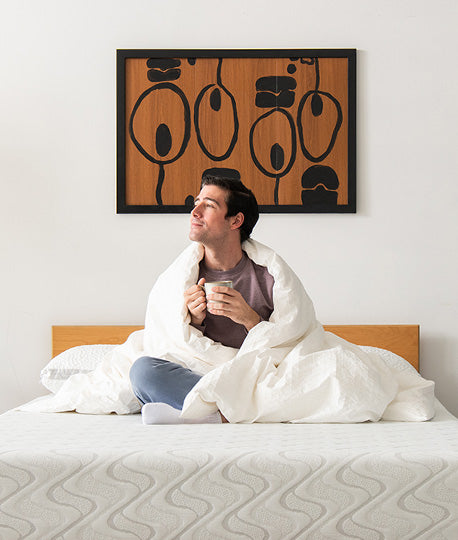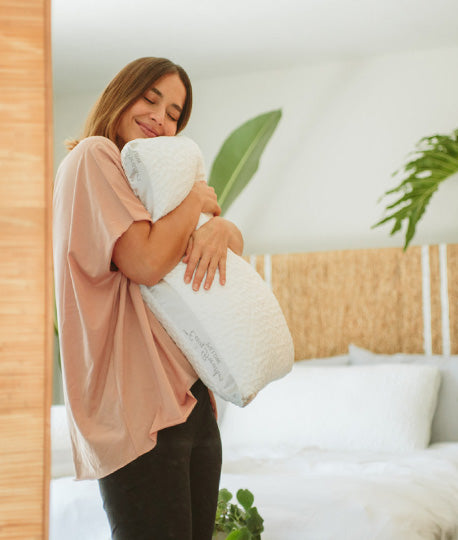
When we fall asleep—entering into the dream-state and then deep sleep—one of the primary physiological changes that our body undergoes is a change in brainwave patterns. In particular, sleep happens with lower-frequency Theta and Delta brain waves.
So, if we're having a hard time falling asleep, one way of encouraging the body to drift off to sleep is to intentionally transform our brainwave patterns to the Theta and Delta frequencies. And the technology of binaural beats is one fascinating and effective way of doing this.
But what exactly are binaural beats? How do they work? And how can they be used to improve the quality of sleep? Read on for answers to these questions, and more.
What Are Binaural Beats?
Binaural beats harness the brain's responsiveness to sound to ease you into states of deep relaxation and help you sleep better (along with accomplishing other benefits).
The technology is based upon the understanding that sound has the power to influence our brain—and hence, our entire body and mind. The specific way it impacts us depends on the composition of frequencies within the sound.
The binaural beat process allows for specific frequencies to be isolated, which are known to influence the brain in positive, beneficial, healing ways.
This process by which sound affects brainwave patterns is known as "entrainment."
The actual technique involves combining two slightly different sound frequencies—each heard via one of your two ears, through the two sides of stereo headphones—to create the perception, within the brain, of a single new frequency tone. This new tone is called a "beat." And "binaural" refers to the stereo sound through which the beat (the new tone) is created.
The History Of Binaural Beats
The discovery of the binaural beat process is attributed to the Prussian physicist and meteorologist Heinrich Wilhelm Dove—whose experiments reached their successful apex in 1839.
It wasn't, however, until more than a century later (in 1973) that the biophysicist Dr. Gerald Oster introduced binaural beats to a much broader and more mainstream audience—via his paper "Auditory Beats in the Brain," which was published in the prestigious Scientific American journal.
Since that time, binaural beats have been studied in great detail—and have been proven scientifically to be linked with many physical, mental, and emotional benefits, including improved sleep.
To understand more clearly how exactly binaural beats can be used to help us sleep better, we need first to learn a bit more about the different types of brain waves.
Types Of Brainwaves: Delta, Theta, Alpha, Beta & Gamma
The human brain exhibits five different brainwave states, each associated with a specific frequency range. The speed of these brain waves are measured in Hertz (Hz). And each of these frequencies can support unique benefits:
- Delta (0.1-4 Hz): Used to promote deep sleep, healing, pain relief, and anti-aging.
- Theta (4-8 Hz): Used to nourish deep relaxation, REM sleep, meditation, inner peace, and creativity.
- Alpha (8-14 Hz): Used for stress relief, increased learning, and enhancing a positive mindset.
- Beta (14-30 Hz): Used to enhance focused attention, productive thinking and problem-solving, and to increase waking-state energy.
-
Gamma (30+ Hz): Used to amplify clear awareness and high-level mental activity, support peak performance, and heighten the senses.
As you can see from this list of brainwave states, the faster (i.e., higher frequency) the brainwave pattern, the greater your state of arousal. On the other hand: the slower (lower frequency) the brainwaves are, the deeper your state of relaxation—or sleep.
Binaural Beats For Improved Sleep
More and more people are discovering how binaural beats can help us sleep better. They're becoming a popular remedy for those suffering from sleep impairments—and are a wonderfully safe alternative to pharmaceuticals, for those who would rather avoid taking sleep medications.
As we saw above, two specific brainwave frequencies help put our brains into a sleep mode: Delta and Theta.
Delta is the lowest of all the frequencies and is associated with deep sleep, in which there is no dreaming. Deep sleep is the type of sleep which our body needs for its "rest and restoration" function, i.e., to activate its self-healing protocols.
Theta frequencies support a drowsy, relaxed state that eventually leads to REM sleep and dreaming.
Binaural beats that create a slowing down of brainwave activity—into the Theta or Delta frequencies—can help you relax, lower stress and anxiety levels, and make it easier to fall asleep and then sleep deeply.
And, as reported in Psychology Today, the physiological effects of binaural beats include not only changes in brain-wave frequency, but also beneficial changes in the endocrine system. For instance, one study found that exposure to binaural beats is associated with changes to three hormones important to sleep and overall well being:
- DHEA
- Cortisol
- Melatonin
In short: By entraining brainwaves to low-frequency Theta and Delta states, and modulating sleep-inducing hormones, binaural beats promote deeper states of relaxation and help you sleep better.
Binaural Beats Tips & Protocol For Deeper Sleep
Here are a few tips that will help you to be successful in using binaural beats to support more profound relaxation and sounder sleep:
- Invest in a pair of high-quality stereo headphones.
- Listen to Theta and Delta beats over several days or weeks—to entrain your brainwaves to these new frequencies.
- Start listening to the binaural beats about two hours before your bedtime. So for instance, if you go to bed at 10:00 pm, then begin listening to Theta binaural beats at around 8:00 pm, and then to Delta binaural beats right as you lie down to go to sleep.
- An excellent source for binaural beats is Jeffrey Thompson—a musical artist whose work incorporates the science of binaural beats and brain entrainment.
Sweet Dreams!
As we've outlined above, the technology of binaural beats offers a useful tool for helping you relax and sleep more deeply. Combining this with some high-quality bedding and a wonderfully comfortable mattress all but assures that your sleep will be profoundly restorative and that it will also include an inspiring variety of sweet dreams!
Questions or comments? Please feel free to contact us.






